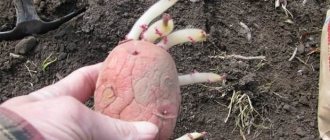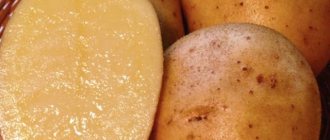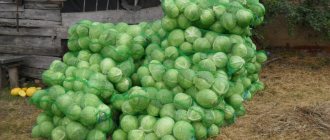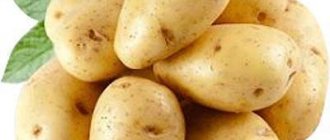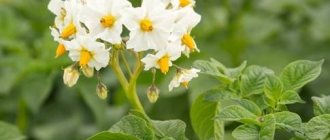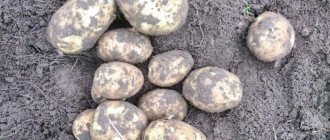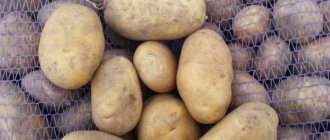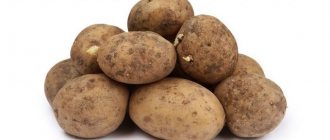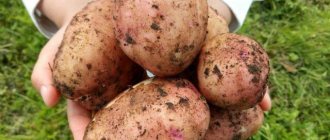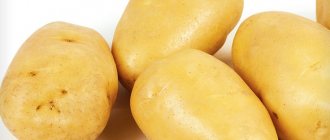Description and characteristics of Agatha
Mid-season table potatoes Agata are sensitive to fertile soils and fertilizers. In the fields, the average yield is 250 centners/ha; with intensive technologies, up to 400 centners are harvested. The first tubers can be dug after 50-55 days, already in July, full ripening - in August, after 80-85 days. Tubers are well preserved until spring, their shelf life is 93%.
Low, erect Agata potato bushes are moderately spreading, with medium leafy stems. The leaf is small, the edges are slightly wavy. The flowers are white and are not produced on all bushes; fruits are produced rarely. A developed root system allows the bush to grow 10-15 large tubers. There are few small potatoes.
The oval-elongated tubers are uniform, neat in appearance, with small eyes. Weight 70-140 g, on average most tubers are above 100 g. The peel is smooth, light yellow, the flesh is dense, yellowish-cream. The tubers contain 12-14% starch, so the potatoes do not boil, but the mashed potatoes are tasty and airy. The variety is suitable for frying, baking, making chips, frozen vegetable mixtures, and freeze-dried purees. During culinary processing, the Agata potato pulp remains light and the taste is rich.
Attention! In the northern regions, potato rows are oriented towards the south for better insolation.
Collection, storage and use of crops
The final harvest is harvested in August, but the first diggings begin in mid-July .
2-3 days before harvesting, the tops are cut off, leaving at least 10 cm. The fruits are dug up with a pitchfork or shovel and left to dry between the rows or put under a canopy if precipitation is forecast. After drying, the potatoes are ready for long-term storage in dry and cool rooms.
Agatha is grown not only in small summer cottages, but also on an industrial scale , in the fields. The shelf life of ripe fruits is high; 93% of the entire harvest retains its presentation. There are practically no small potatoes. All fruits are large and level.
Ripe vegetables are ideal not only for preparing first and second courses , but also for semi-finished products and chips.
Advantages and disadvantages
Agata potatoes are loved by farm owners for their productive potential. The variety performed well on any soil, but on more fertile lands the harvest is richer. The advantages of the variety are obvious:
- Ability to bear fruit on different types of soil;
- High and stable yield;
- Excellent consumer qualities;
- Commercial form of tubers;
- Transportability and keeping quality;
- Versatility of use;
- Resistance to common potato diseases.
Among the disadvantages of the Agata variety is the susceptibility of potatoes to late blight. But not a single variety has resistance against the disease.
Farmer reviews
Garden owners value the crop for its unpretentiousness in terms of soil and climate and early ripening, which gives a bountiful harvest - up to 1 kg per bush. Agatha’s resistance to diseases does not go unnoticed. To ensure good yields, it is necessary to install a clear irrigation system, feed the soil abundantly and regularly loosen it for better oxygen supply to the tubers.
Housewives praise the fruits of the Agata potato for its pleasant taste and friability, convenient for preparing certain dishes - these data are confirmed by the characteristics.
Landing
For Agata potatoes, early planting is recommended, from the second ten days of April, when warm weather sets in. The soil should warm up to 10 °C at a depth of planting seed material - 8-10 cm. The Agata variety can also grow on heavy clay soils, the tubers are planted shallow - up to 6 cm. On sandy loam soils they are placed deeper - up to 8-10 cm. If in the fall on the site did not apply fertilizers, humus can be laid before cultivating the land - 5 kg per 1 sq. m.
Potatoes are taken out of the basement a month before planting and sorted, discarding diseased and damaged tubers. Lay out a thin layer in 2-3 rows in boxes for germination. Light sprouts of the Agata variety are oval, pink, pubescent. On the day of planting, the tubers are sprayed against possible fungal infections with Fitosporin; Prestige is used to repel Colorado beetles or other drugs are used for these purposes according to the instructions. Tubers are also treated with growth stimulants.
Advice! To germinate potatoes, the room temperature must be at least 12-15 oC.
Agata potatoes are planted in a spacious sunny area on high ridges or form ridges. The tubers are provided with sufficient area for nutrition: row spacing is 70-75 cm wide, the distance between Agata bushes is 25-30 cm.
Important! On personal plots, add 0.5-1 liters of rotted humus and 0.2 liters of wood ash into the holes.
The best late potato varieties for winter consumption
Golubizna (Russia, 1993)125 (1 kg, elite) Mid-late table potato variety. The period from planting to ripening of tubers is 100 days. Bushes of medium height, semi-spreading, with dark green glossy leaves of medium size. The flowers are bluish in color. The tubers are round-oval, rough, pale beige, with creamy pulp, weighing 90–110 g, with wide surface eyes, containing 17–19% starch. When cooked, they crumble quickly and are suitable for making purees. 17 - 25 medium and small potatoes are formed in the nest. Susceptibility to late blight is average, high resistance to cancer, scab, and rhizoctonia. In the register for the Central, Volga-Vyatka, Central Black Earth and North Caucasus regions. For the variety, dense planting with row spacing of 75 cm is recommended. Main advantages:
Minuses:
| 9.8 / 10 Rating Reviews The variety is completely satisfactory. The tubers are smooth, not very lumpy, easy to clean. After winter, potatoes do not germinate in the cellar, so I specially germinate them before planting. |
Kolobok (Russia, 2005)95 (1 kg, elite) A good mid-season universal potato variety for amateur and industrial cultivation. From planting to harvesting, 85–100 days pass. Bushes of medium height, powerful, moderately spreading. The leaves are large, light green, slightly wavy. The flowers are white and large. The tubers are round, lumpy, with a few small eyes of medium depth, with yellow skin and pulp, weighing 90 - 120 g, containing 11 - 13% starch. 15–18 tubers are formed in one nest. The taste is rated as good. The friability is medium, suitable for purees and frying. The flesh is no darker after cooking. It forms a spreading nest, so during mechanical harvesting there is a high probability of cut tubers. This potato variety is approved for cultivation in the Central region; it shows good results in Bashkiria and the Central Black Earth Region. Main advantages:
Minuses:
| 9.7 / 10 Rating Reviews The variety has taken root on our site. I don’t add a lot of humus to it, since excess nitrogen impairs the taste and preservation. The potatoes are leveled, the shape is convenient for peeling and slicing. |
Skarb (Belarus, 2002)180 (10 mini tubers) Mid-season table potato variety. The bushes are medium-sized, semi-erect, with medium-sized dark green leaves. The flowers are white. The tubers are oval, with small superficial eyes, with a smooth yellow skin and light yellow pulp, weighing 95 - 140 g, containing 11 - 18% starch. The nest is compact, which makes digging easier; contains 10 – 14 tubers. They cook poorly, so the main use is chips, French fries, salads and frying. In the register for the North-Western, Central, Volga-Vyatka and Ural regions. Sensitive to waterlogging. It is characterized by uneven germination and flowering. Due to the long period of dormancy, it does not sprout for a long time; pre-warming and germination of the tubers is required. Main advantages:
Minuses:
| 9.6 / 10 Rating Reviews Our insurance variety of potatoes is always productive, good taste, and shelf-stable. Confidently stored until the next harvest. |
Care
The plot with Agata variety potatoes is loosened after emergence. When there is a threat of return frosts, the sprouts are spudded, completely covering the tops with soil. During the season, the bushes are weeded and hilled three times before flowering. At the same time, weeds are removed. Be sure to loosen the soil after watering so that it is more breathable.
For the Agata variety, it is recommended to use a drip irrigation system to ensure uniform soil moisture. Early potatoes develop intensively and require enough moisture.
- In dry summers, Agata potatoes are watered for the first time when the seedlings rise to 15 cm. Each bush must be given at least 3 liters of warm water;
- In the budding phase, the required amount of water doubles;
- When the Agata variety tubers gain weight, each plant is given up to 12 liters of water.
Advice! After the last hilling of the potatoes, the row spacing is mulched with dry hay or straw.
The yield of the Agata variety increases on fertile soils and with timely fertilizing.
- Before the first hilling, fertilize with urea: 20 g of the product per 10 liters of water - 0.5 liters per bush;
- In the rows, water with a solution of mullein 1:10, infusion of bird droppings 1:15 or herbal infusion with wood ash;
- Apply, in accordance with the instructions, solutions of complex mineral fertilizers Kemira, Kristalon, Omu, organomineral preparations Bulba, Ispolin and other fertilizing after abundant watering.
The following foliar feedings are effective for the Agata variety:
- 15 days after germination, spray with a mixture of 100 g of urea, 150 g of potassium monophosphate, 5 g of boric acid in 10 liters of water. After 2 weeks, the treatment is repeated, but the amount of drugs is diluted in 5 liters of water;
- A month before digging the potatoes, they treat each leaf with superphosphate: 100 g is diluted in 10 liters of water per 10 square meters. m.
Dutch potatoes of the "Agatha" variety
Agata is not just a beautiful name, but one of the easily adaptable, unpretentious and productive potato varieties. Undemanding in care, resistant to most negative factors that affect its fellows. And the quality of the tubers and their taste are at a decent level.
Description and characteristics of agate
Agate potatoes are unique, which will confirm the description of the variety.
| Main characteristics | variety bred in the Netherlands, intended for table use, suitable for long-term storage and transportation |
| Climate required for cultivation | adapted to any substrate, bred for cultivation on sandy and loamy soils, as well as in regions with a short summer period |
| Indicator of keeping quality of tubers | 93% subject to the necessary storage and transportation conditions |
| Maturation period | from 50 days for collecting the first tubers and up to 85 days for full ripening and harvesting a full harvest |
| Number of tubers per bush | 10-13 fruits |
| Average weight of a ripe tuber | about 100 grams, weight variability within 70-140 grams |
| Taste qualities | the taste is rich and pleasant. The variety is universal, as it is suitable for boiling, frying, baking, stewing |
| Amount of starch, chemical composition | the starch indicator does not exceed 14%, the average is 13%, contains iodine, magnesium, zinc, iron |
| Productivity (depending on soil fertility) | from 300 to 400 centners per 1 hectare of plantings |
| Color indicators | The peel of the fruit is yellow, the flesh is white with a slight creamy tint |
| Disease susceptibility | late blight affecting tubers and tops |
Advantages and disadvantages
Agatha's strengths:
- good fruitfulness;
- high productivity;
- adaptability to northern climates and poor soils;
- transportability and storage;
- the versatility of fruits in the methods of their preparation;
- increased immunity to diseases and pests common among other varieties.
Agate potatoes have only one significant drawback and this is instability to damage by parasites, the general type of which is called late blight. The disease caused by them is called late blight, however, there are effective ways to combat it.
Features of growing agate
The soil for this root crop must be prepared in the fall. The area should be well lit and free of shadows
When preparing it, special attention is paid to the removal of weeds and previous agricultural crops, as well as digging up the soil and its advance treatment with fertilizers such as potassium, phosphorus, and manure.
Care
A potato variety such as agatha requires hilling twice during the entire period of its life. The first time this is done a month after planting, and the second time on the eve of flowering. Weeds are removed as they appear.
Agatha is watered three times during the entire growing season. The first watering is carried out when the seedlings reach a height of 15 cm. At least three liters of warm water are consumed for each bush; a smaller volume will significantly reduce the quality of the root crop.
As soon as the flowers bloom, agate potatoes require new watering to maintain the desired water balance. By this point, each bush already needs 6 liters.
After each of the waterings described above, it is important not to forget about aeration of the soil; it must be loosened to saturate the roots with oxygen.
Diseases and pests
The Agata potato variety does not suffer from potato cancer and scab. It has average resistance to fusarium wilt and late blight of tops. To prevent the disease, the bushes are prophylactically treated with manganese and the drugs Oxychom, Ridomil, and Arcedil. The same means are used, upon noticing a disease, to save tubers. After harvesting in the area where late blight was noticed, the seed tubers are treated with Immunocytophyte and kept in the air for a long time without being stored.
Agata potatoes resist nematode infection, and against other pests on the site they use “Medvedtox”, “Gromoboy”, and special insecticides against Colorado potato beetles.
